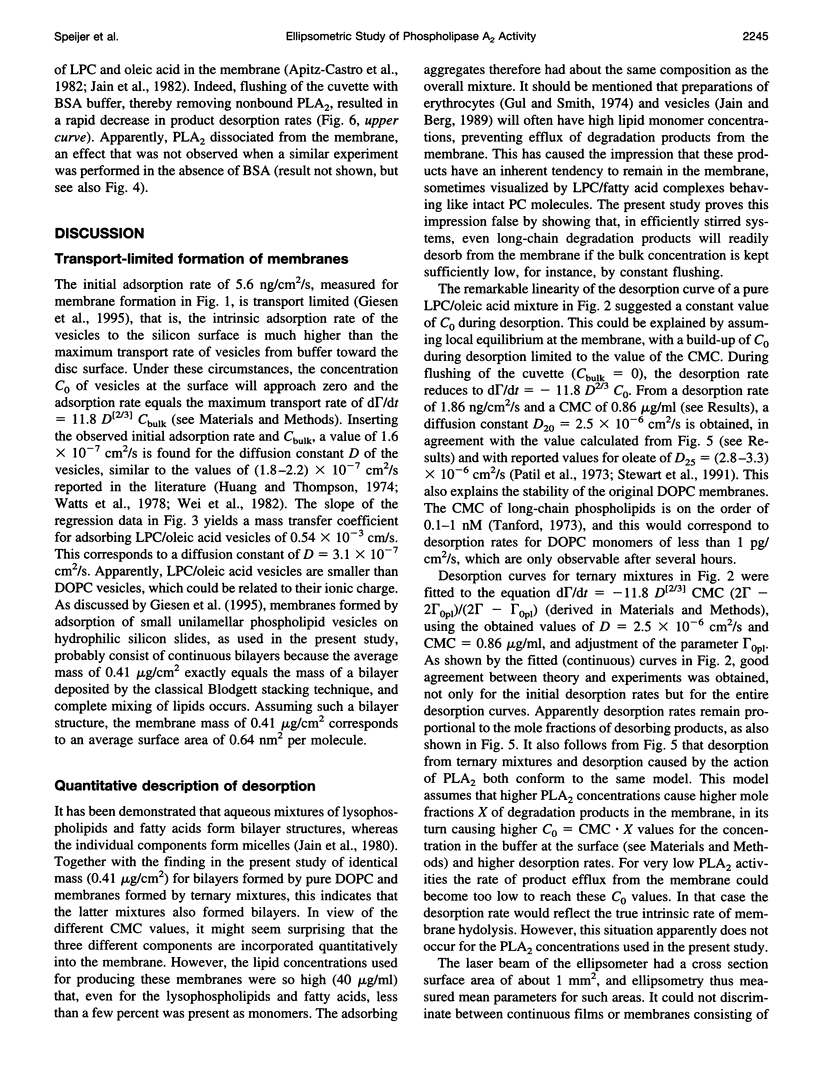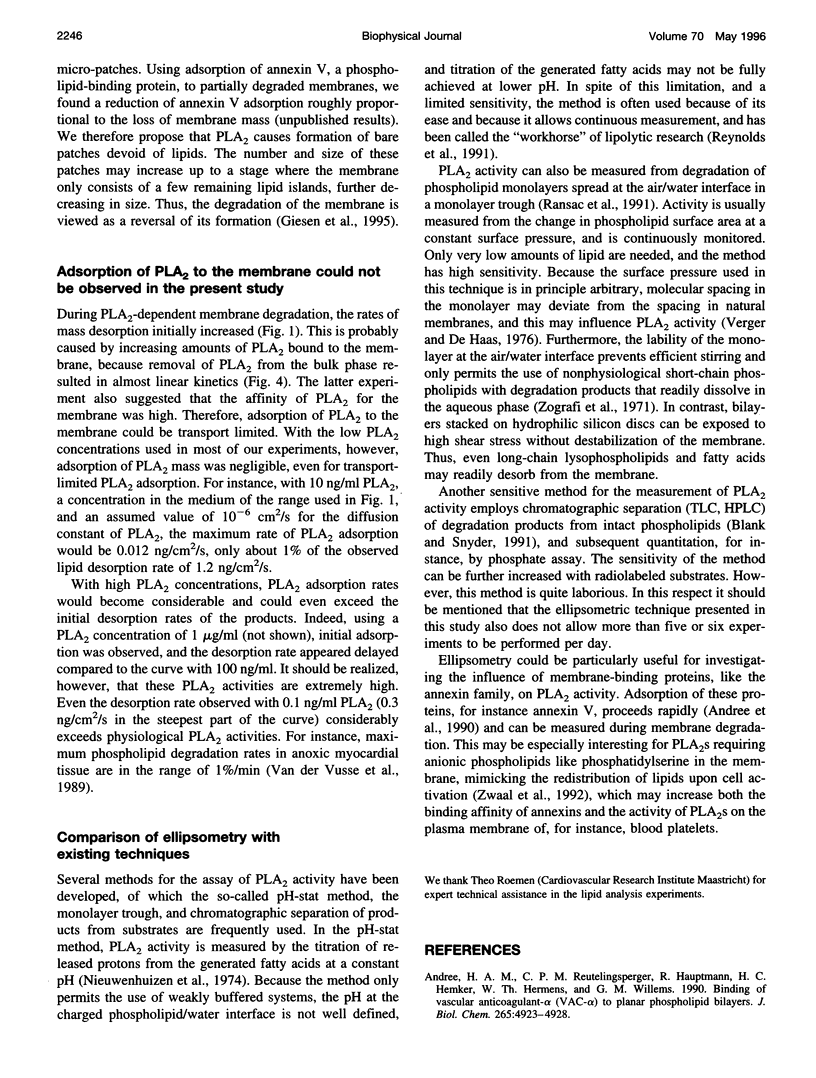Abstract
In phospholipid membranes attacked by phospholipase A(2) (PLA(2)), accumulation of degradation products influences the binding affinity as well as the catalytic activity of PLA(2). Such accumulation in its turn depends on the rate of membrane degradation and the efflux of degradation products from the membrane, the latter being influenced by the stirring conditions in the system. This complicated process was investigated with a new ellipsometric technique for in situ measurement of membrane mass in a well-defined flow system. Planar phospholipid bilayers were formed on rotating silicon discs in buffer solution. After the addition of 0.05-100 ng/ml of PLA(2) (from Naja mocambique mocambique) to the buffer, mass desorption could be measured with a precision of 3-5 ng/cm(2), that is, about 1% of the surface mass of a single bilayer. Using radiolabeled phospholipids and thin-layer chromatography, it was verified that only the degradation products desorb from the membrane, which was confirmed by the desorption of mixtures of phospholipids, lysophospholipids, and fatty acids. The rotating disc allows the exact calculation of the mass transfer constant for transport-limited exchange of lipid between fluid and disc surface, as a function of rotation rate. By using the mass transfer constant, the critical micelle concentrations, and the mole fractions of products, desorption kinetics could be fully described. The amount of degraded phospholipid could be continuously monitored as the sum of the product mass still present in the membrane, as inferred from the desorption rate, and the mass already lost from the surface. It is concluded that ellipsometry is a suitable tool for studying the effects of PLA(2) on membranes.
Full text
PDF








Selected References
These references are in PubMed. This may not be the complete list of references from this article.
- Andree H. A., Reutelingsperger C. P., Hauptmann R., Hemker H. C., Hermens W. T., Willems G. M. Binding of vascular anticoagulant alpha (VAC alpha) to planar phospholipid bilayers. J Biol Chem. 1990 Mar 25;265(9):4923–4928. [PubMed] [Google Scholar]
- Apitz-Castro R., Jain M. K., De Haas G. H. Origin of the latency phase during the action of phospholipase A2 on unmodified phosphatidylcholine vesicles. Biochim Biophys Acta. 1982 Jun 14;688(2):349–356. doi: 10.1016/0005-2736(82)90346-7. [DOI] [PubMed] [Google Scholar]
- Blank M. L., Snyder F. Chromatographic analysis of phospholipase reaction products. Methods Enzymol. 1991;197:158–165. doi: 10.1016/0076-6879(91)97142-l. [DOI] [PubMed] [Google Scholar]
- Brian A. A., McConnell H. M. Allogeneic stimulation of cytotoxic T cells by supported planar membranes. Proc Natl Acad Sci U S A. 1984 Oct;81(19):6159–6163. doi: 10.1073/pnas.81.19.6159. [DOI] [PMC free article] [PubMed] [Google Scholar]
- Cuypers P. A., Corsel J. W., Janssen M. P., Kop J. M., Hermens W. T., Hemker H. C. The adsorption of prothrombin to phosphatidylserine multilayers quantitated by ellipsometry. J Biol Chem. 1983 Feb 25;258(4):2426–2431. [PubMed] [Google Scholar]
- Giesen P. L., Hemker H. C., Hermens W. T. Production of thrombin as a probe for mixing of phospholipids in membranes on solid supports. Biochim Biophys Acta. 1995 Jul 6;1237(1):43–48. doi: 10.1016/0005-2736(95)00109-g. [DOI] [PubMed] [Google Scholar]
- Giesen P. L., Willems G. M., Hermens W. T. Production of thrombin by the prothrombinase complex is regulated by membrane-mediated transport of prothrombin. J Biol Chem. 1991 Jan 25;266(3):1379–1382. [PubMed] [Google Scholar]
- Gul S., Smith A. D. Haemolysis of intact human erythrocytes by purified cobra venom phospholipase A2 in the presence of albumin and Ca2+. Biochim Biophys Acta. 1974 Nov 15;367(3):271–281. doi: 10.1016/0005-2736(74)90084-4. [DOI] [PubMed] [Google Scholar]
- Huang C., Thompson T. E. Preparation of homogeneous, single-walled phosphatidylcholine vesicles. Methods Enzymol. 1974;32:485–489. doi: 10.1016/0076-6879(74)32048-4. [DOI] [PubMed] [Google Scholar]
- Jain M. K., Berg O. G. The kinetics of interfacial catalysis by phospholipase A2 and regulation of interfacial activation: hopping versus scooting. Biochim Biophys Acta. 1989 Apr 3;1002(2):127–156. doi: 10.1016/0005-2760(89)90281-6. [DOI] [PubMed] [Google Scholar]
- Jain M. K., Egmond M. R., Verheij H. M., Apitz-Castro R., Dijkman R., De Haas G. H. Interaction of phospholipase A2 and phospholipid bilayers. Biochim Biophys Acta. 1982 Jun 14;688(2):341–348. doi: 10.1016/0005-2736(82)90345-5. [DOI] [PubMed] [Google Scholar]
- Jain M. K., Ranadive G., Yu B. Z., Verheij H. M. Interfacial catalysis by phospholipase A2: monomeric enzyme is fully catalytically active at the bilayer interface. Biochemistry. 1991 Jul 23;30(29):7330–7340. doi: 10.1021/bi00243a038. [DOI] [PubMed] [Google Scholar]
- Jain M. K., van Echteld C. J., Ramirez F., de Gier J., de Haas G. H., van Deenen L. L. Association of lysophosphatidylcholine with fatty acids in aqueous phase to form bilayers. Nature. 1980 Apr 3;284(5755):486–487. doi: 10.1038/284486a0. [DOI] [PubMed] [Google Scholar]
- Kop J. M., Cuypers P. A., Lindhout T., Hemker H. C., Hermens W. T. The adsorption of prothrombin to phospholipid monolayers quantitated by ellipsometry. J Biol Chem. 1984 Nov 25;259(22):13993–13998. [PubMed] [Google Scholar]
- Kupferberg J. P., Yokoyama S., Kézdy F. J. The kinetics of the phospholipase A2-catalyzed hydrolysis of Egg phosphatidylcholine in unilamellar vesicles. Product inhibition and its relief by serum albumin. J Biol Chem. 1981 Jun 25;256(12):6274–6281. [PubMed] [Google Scholar]
- Nieuwenhuizen W., Kunze H., de Haas G. H. Phospholipase A2 (phosphatide acylhydrolase, EC 3.1.1.4) from porcine pancreas. Methods Enzymol. 1974;32:147–154. doi: 10.1016/0076-6879(74)32018-6. [DOI] [PubMed] [Google Scholar]
- Patil G. S., Matthews R. H., Cornwell D. G. Kinetics of the processes of desorption from fatty acid monolayers. J Lipid Res. 1973 Jan;14(1):26–31. [PubMed] [Google Scholar]
- Ransac S., Moreau H., Rivière C., Verger R. Monolayer techniques for studying phospholipase kinetics. Methods Enzymol. 1991;197:49–65. doi: 10.1016/0076-6879(91)97132-i. [DOI] [PubMed] [Google Scholar]
- Reynolds L. J., Washburn W. N., Deems R. A., Dennis E. A. Assay strategies and methods for phospholipases. Methods Enzymol. 1991;197:3–23. doi: 10.1016/0076-6879(91)97129-m. [DOI] [PubMed] [Google Scholar]
- Smith A. D., Gul S., Thompson R. H. The effect of fatty acids and of albumin on the action of a purified phospholipase A 2 from cobra venom on synthetic lecithins. Biochim Biophys Acta. 1972 Nov 10;289(1):147–157. doi: 10.1016/0005-2744(72)90117-9. [DOI] [PubMed] [Google Scholar]
- Stewart J. M., Driedzic W. R., Berkelaar J. A. Fatty-acid-binding protein facilitates the diffusion of oleate in a model cytosol system. Biochem J. 1991 May 1;275(Pt 3):569–573. doi: 10.1042/bj2750569. [DOI] [PMC free article] [PubMed] [Google Scholar]
- Verger R. Interfacial enzyme kinetics of lipolysis. Annu Rev Biophys Bioeng. 1976;5:77–117. doi: 10.1146/annurev.bb.05.060176.000453. [DOI] [PubMed] [Google Scholar]
- Watts A., Marsh D., Knowles P. F. Characterization of dimyristoylphosphatidylcholine vesicles and their dimensional changes through the phase transition: molecular control of membrane morphology. Biochemistry. 1978 May 2;17(9):1792–1801. doi: 10.1021/bi00602a034. [DOI] [PubMed] [Google Scholar]
- Wei G. J., Bloomfield V. A., Resnick R. M., Nelsestuen G. L. Kinetic and mechanistic analysis of prothrombin-membrane binding by stopped-flow light scattering. Biochemistry. 1982 Apr 13;21(8):1949–1959. doi: 10.1021/bi00537a039. [DOI] [PubMed] [Google Scholar]
- Weisiger R. A., Pond S. M., Bass L. Albumin enhances unidirectional fluxes of fatty acid across a lipid-water interface: theory and experiments. Am J Physiol. 1989 Dec;257(6 Pt 1):G904–G916. doi: 10.1152/ajpgi.1989.257.6.G904. [DOI] [PubMed] [Google Scholar]
- Willems G. M., Giesen P. L., Hermens W. T. Adsorption and conversion of prothrombin on a rotating disc. Blood. 1993 Jul 15;82(2):497–504. [PubMed] [Google Scholar]
- Zografi G., Verger R., de Haas G. H. Kinetic analysis of the hydrolysis of lecithin monolayers by phospholipase A. Chem Phys Lipids. 1971 Dec;7(4):185–206. doi: 10.1016/0009-3084(71)90001-6. [DOI] [PubMed] [Google Scholar]
- Zwaal R. F., Comfurius P., Bevers E. M. Platelet procoagulant activity and microvesicle formation. Its putative role in hemostasis and thrombosis. Biochim Biophys Acta. 1992 Oct 13;1180(1):1–8. doi: 10.1016/0925-4439(92)90019-j. [DOI] [PubMed] [Google Scholar]
- van Bilsen M., van der Vusse G. J., Willemsen P. H., Coumans W. A., Roemen T. H., Reneman R. S. Lipid alterations in isolated, working rat hearts during ischemia and reperfusion: its relation to myocardial damage. Circ Res. 1989 Feb;64(2):304–314. doi: 10.1161/01.res.64.2.304. [DOI] [PubMed] [Google Scholar]
- van der Vusse G. J., Glatz J. F., Stam H. C., Reneman R. S. Fatty acid homeostasis in the normoxic and ischemic heart. Physiol Rev. 1992 Oct;72(4):881–940. doi: 10.1152/physrev.1992.72.4.881. [DOI] [PubMed] [Google Scholar]
- van der Vusse G. J., Roemen T. H., Reneman R. S. Assessment of fatty acids in dog left ventricular myocardium. Biochim Biophys Acta. 1980 Feb 22;617(2):347–349. doi: 10.1016/0005-2760(80)90176-9. [DOI] [PubMed] [Google Scholar]
- van der Vusse G. J., de Groot M. J., Willemsen P. H., van Bilsen M., Schrijvers A. H., Reneman R. S. Degradation of phospholipids and triacylglycerol, and accumulation of fatty acids in anoxic myocardial tissue, disrupted by freeze-thawing. 1989 Jun 27-Jul 24Mol Cell Biochem. 88(1-2):83–90. doi: 10.1007/BF00223428. [DOI] [PubMed] [Google Scholar]


